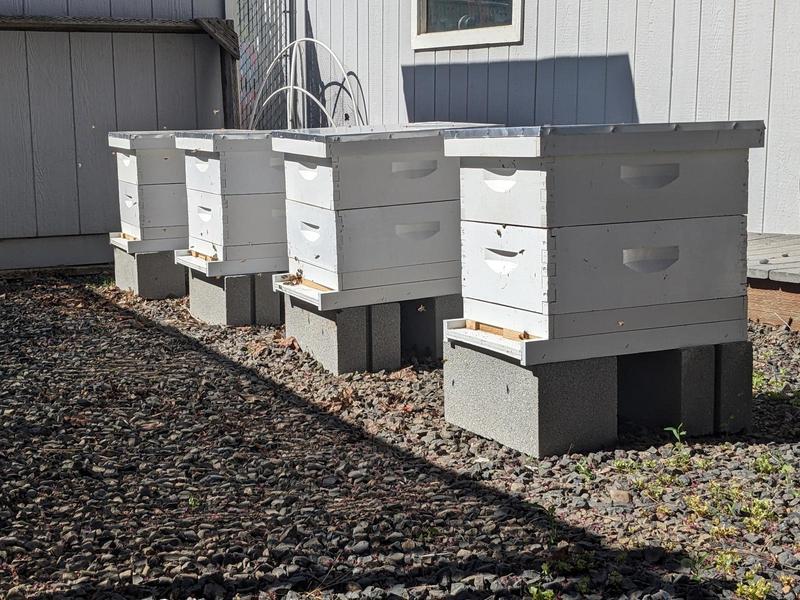
Why We Started Beekeeping—And How It's Going!
Why bees?
First, we liked the idea of adding another type of production to our suburban homestead. Because we do not have a large amount of land (currently, about a quarter acre of yard space), we are limited in the types of things we can do—no beef cows, for instance. Beehives have a relatively small footprint. If they do well, they can be a lot of bang for their buck.
Second, we eat a lot of honey. I make granola and energy balls; we eat honey on yogurt and oatmeal, put honey in tea, spread honey and butter on fresh bread, among other uses. We normally buy local raw honey. Why not produce our own?
Also, having more local pollinators is beneficial for the garden.
My husband Randy will be the main beekeeper. But we're all learning about the process!
Our setup
We have four langstroth hives. We decided to get four because we had space for four; plus, this way, if one or two don't do well or don't survive the winter, we'll still have the others!
They use all medium depth supers (the boxes), rather than any deep supers. Some people use deep supers for the bottom of the hive, where the queen lives and the brood is raised, and place medium supers above for honey production.

We decided to use all medium supers for a couple reasons. First, the deep boxes get very, very heavy when full of comb, honey, and brood. That makes it hard to move the lower supers if you need to check in on them. Even our shallow boxes can be upwards of 40 lbs when full!
Second, if all the boxes are the same size, then all the frames within are swappable. So, for instance, if you want to split a hive or start a new hive, you can take frames from any of the rest of your supers in any of your hives to add to the new one. You can take frames of honeycomb and honey from the honey supers and put those in a new brood box to give the bees a head start.
We purchased our bees already installed in the hives from a family that we met at our co-op (read about it!); the all-medium-supers method is their preference, and it seems reasonable to us!
We put the hives along one side of our house. We're on a corner lot. The side along the street is filled with landscaping rocks, a shed, and the shadow of a large purple plum tree. It's not a wide area; it's not useful for much else. Perfect for the bees! The hives face out toward the fence, so the bees fly out, up, over, and away to forage.
How they're doing so far
Randy has been checking the hives every week or two—with one exception. A few weeks ago, we were very busy with lots of other things… and missed a hive inspection. This turned out to be a critical miss!

One reason to check the hives regularly is to see if the bees need more space. If they fill up their supers with comb and honey, and have no more room, the hive may split. Some of the bees take the queen, swarm, and leave, off to make their own hive, while the remaining bees raise a new queen. If you give the bees an additional super on top—making the hive taller—they're likely to stay and make more honey for you, instead of swarming.
One of our hives was full. Randy ordered the new supers—we didn't have any extras on hand. One day before the new supers arrived, the hive swarmed.
It was actually really cool to see how many bees there were! They filled the air, then clumped onto a branch in our crabapple tree. Then… they left. Sometimes, beekeepers can catch swarms and install them in a new hive. In this case, one of our hives is raising a new queen and is a little behind on population…
We have since added new supers to the hives, so none of the others are in danger of swarming. Two of them are doing very well, already filling the fourth super with comb and honey!



And what about honey?
We've been learning about harvesting honey—how much to leave for the bees for the winter, how to tell if honey is ready, how to extract it from the comb, what equipment we'll need. A lot of beekeepers in our climate leave two deep boxes, or three medium boxes, for the bees in the winter. With the bees filling in the fourth, we're hoping at least two hives will have some frames of honey for us this year!
We've gotten a little taste already. When Randy opens up the hives, sometimes the bees have built out comb in between the supers. Sometimes, he needs to scrap it off in order to put the supers back on properly… so we collect it! This honey is very light in color and incredibly flavorful. We only have a bit so far, but enough to know beekeeping is worth it!

The kids have also quickly figured out that hive inspections can mean honey. Last time Randy said he was going out to check the bees, our 2-year-old ran after him shouting, "I'm getting a spoon!"


Book Review: The Power of Habit: Why We Do What We Do In Life and Business by Charles Duhigg
